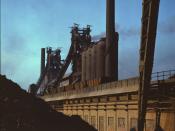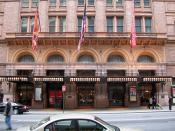Carnegie was born in Dunfermline, Scotland. He went to the U.S. in 1848 and soon began work as a bobbin boy in a cotton mill in Allegheny, Pennsylvania, for $1.20 per week. The following year he became a messenger in a Pittsburgh telegraph office and learned telegraphy. He was then employed by the Pennsylvania Railroad as the private secretary and telegrapher to the railroad official Thomas Alexander Scott. Carnegie advanced by successive promotions until he was superintendent of the Pittsburgh division of the railroad.
His financial interest in what became the Pullman Palace Car Company laid the foundation of his fortune, and investments in oil lands near Oil City, Pennsylvania, increased his means. During the American Civil War he served in the War Department under Scott, who was in charge of military transportation and government telegraph service. After the war Carnegie left the railroad and formed a company to produce iron railroad bridges.
He later founded a steel mill and was one of the earliest users of the Bessemer process of making steel in the U.S. Carnegie was extremely successful, acquiring a controlling interest in other large steel plants.
By 1899, when he consolidated his interests in the Carnegie Steel Company, he controlled about 25 percent of the American iron and steel production. In 1901 he sold his company to the United States Steel Corp. for $250 million and retired. Carnegie did not have a formal education, but as a youth working in Pennsylvania he developed a life-long interest in books and education. During his lifetime he gave more than $350 million to various educational, cultural, and peace institutions, many of which bear his name. His first public gift was in 1873 for baths in the town of his birth; his largest single gift was in 1911 for $125 million...


